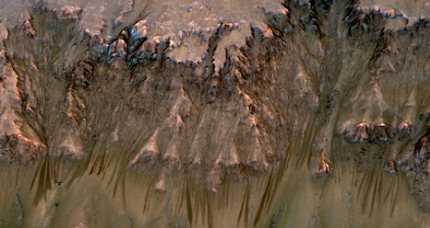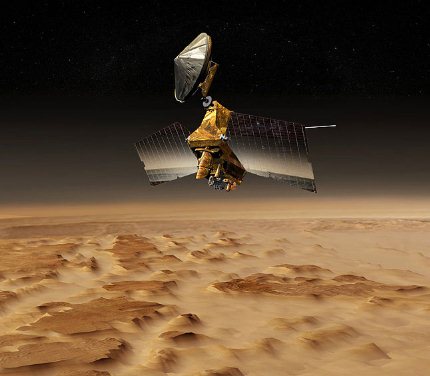NASA's Mars Orbiter hints water flows on The Red Planet- Mars Rover reaches new spot
| Mysterious features on slopes hint there could be water flows on Mars |
 |
| An image combining orbital imagery with 3-D modeling shows flows that appear in spring and summer on a slope inside Mars' Newton crater. Image credit: NASA/JPL-Caltech/Univ. of Arizona |
Earlier water/ice were disovered on our neighbor the Earth's satellite moon. That dicovery was based on ISRO's Chandrayaan and NASA's LRO. Now some more news of "hints" oof water flow on our neighbouring planet Mars - The Red Planet. Seems our natural water resources on earth are dwindiling - scientists are finding on distant planets. The finding marks a significant step in quest to fnd whether living conditons for some form of Life persist on the Red Planet . The observations from NASA's Mars Reconnaissance Orbiter have revealed possible flowing water during the warmest months on Mars.
"NASA's Mars Exploration Program keeps bringing us closer to determining whether the Red Planet could harbor life in some form,” NASA Administrator Charles Bolden said, “and it reaffirms Mars as an important future destination for human exploration."
Dark, finger-like features appear and extend down some Martian slopes during late spring through summer, fade in winter, and return during the next spring. Repeated observations have tracked the seasonal changes in these recurring features on several steep slopes in the middle latitudes of Mars' southern hemisphere.
"The best explanation for these observations so far is the flow of briny water," said Alfred McEwen of the University of Arizona, Tucson. McEwen is the principal investigator for the orbiter's High Resolution Imaging Science Experiment (HiRISE) and lead author of a report about the recurring flows published in recent edition of the journal Science.
Some aspects of the observations still puzzle researchers, but flows of liquid brine fit the features' characteristics better than alternate hypotheses. Saltiness lowers the freezing temperature of water. Sites with active flows get warm enough, even in the shallow subsurface, to sustain liquid water that is about as salty as Earth's oceans, while pure water would freeze at the observed temperatures.
These results are the closest scientists have come to finding evidence of liquid water on the planet's surface today. Frozen water, however has been detected near the surface in many middle to high-latitude regions. Fresh-looking gullies suggest slope movements in geologically recent times, perhaps aided by water. Purported droplets of brine also appeared on struts of the Phoenix Mars Lander. If further study of the recurring dark flows supports evidence of brines, these could be the first known Martian locations with liquid water.
NASA's quest on Mars has not ended just with the orbiter - i also sent two rovers on the surface Spirit and Opportunity in the summer of 2003. Both completed their three-month prime missions in April 2004 and continued years of extended operations. They made important discoveries about wet environments on ancient Mars that may have been favorable for supporting microbial life.
Rover Opportunity finding New Spots
Mean While NASA's rover opportunity keep chugging on the Mars surface travelling to new sites where no Man Made Machine has travelled yet. After a journey of almost three years, NASA’s Mars Exploration Rover Opportunity has reached the Red Planet’s Endeavour crater to study rocks never seen before.Endeavour crater, which is more than 25 times wider than Victoria crater, is 14 miles (22 kilometers) in diameter. At Endeavour, scientists expect to see much older rocks and terrains than those examined by Opportunity during its first seven years on Mars. Endeavour became a tantalizing destination after NASA’s Mars Reconnaissance Orbiter detected clay minerals that may have formed in an early warmer and wetter period.
“We're soon going to get the opportunity to sample a rock type the rovers haven't seen yet,” said Matthew Golombek, Mars Exploration Rover science team member, at NASA’s Jet Propulsion Laboratory (JPL) in Pasadena, Calif. “Clay minerals form in wet conditions so we may learn about a potentially habitable environment that appears to have been very different from those responsible for the rocks comprising the plains.”
The name Spirit Point informally commemorates Opportunity’s twin rover, which stopped communicating in March 2010. Spirit's mission officially concluded in May.
Mars Reconnaissance Orbiter
 |
| Mars Reconnaissance Orbiter |
NASA's Mars Reconnaissance Orbiter, launched August 12, 2005, is on a search for evidence that water persisted on the surface of Mars for a long period of time. While other Mars missions have shown that water flowed across the surface in Mars' history, it remains a mystery whether water was ever around long enough to provide a habitat for life.
After a seven-month cruise to Mars and six months of aerobraking to reach its science orbit, Mars Reconnaissance Orbiter is finding out about the history of water on Mars with its science instruments. They zoomed in for extreme close-up photography of the martian surface, analyzing minerals, looking for subsurface water, tracing how much dust and water are distributed in the atmosphere, and monitoring daily global weather.
One of the Mars Reconnaissance Orbiter's cameras is the largest ever flown on a planetary mission. While previous cameras on other Mars orbiters could identify objects no smaller than a school bus, this camera will be able to spot something as small as a dinner table. That capability will also allow the orbiter to identify obstacles like large rocks that could jeopardize the safety of future landers and rovers. Its imaging spectrometer will also be able to look at small-scale areas about five times smaller than a football field, at a scale perfect for identifying any hot springs or other small water features.
The orbiter's telecommunications systems will also establish a crucial service for future spacecraft, becoming the first link in a communications bridge back to Earth, an "interplanetary Internet" that can be used by numerous international spacecraft in coming years. Testing the use of a radio frequency called Ka-band, Mars Reconnaissance Orbiter may demonstrate the potential for greater performance in communications using significantly less power.
Links
Do You Want to Explore Mars and Be a Citizen of Mars -> Check This Link(Virtual Mars Exploration)
